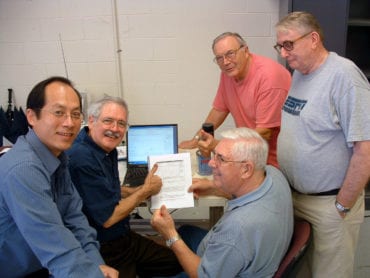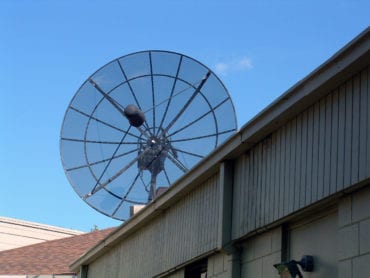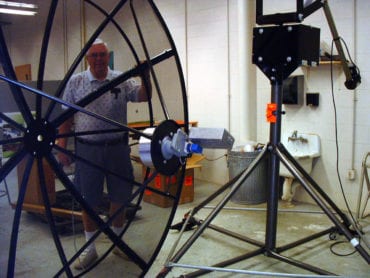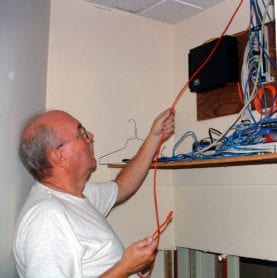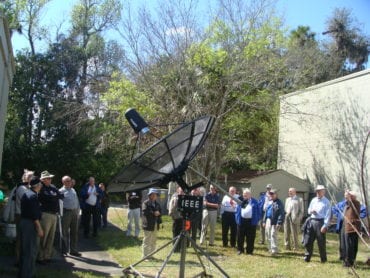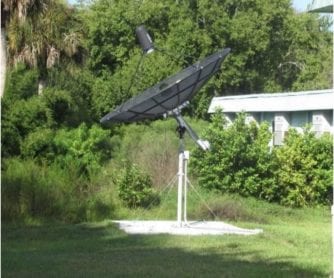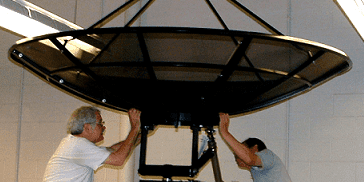Daytona Section Small Radio Telescope (SRT) Program
Small Radio Telescope Program’s Mission Statement
The objective of the Small Radio Telescope Program was to acquire and operate a small radiotelescope in support of a comprehensive educational and research program. This program was directed at increasing the understanding of science and electrical engineering in the local schools and universities of the greater Daytona Beach Area.
Ongoing collaboration and instruction with the SRT at the Burns school is supported by Dr. Hugh Ward, who is working with the school’s science staff to develop lesson plans and experiments for the students interested in the SRT. He’s also been doing some educational presentations using standard telescopes for the faculty and students.
Detailed Narrative with Pictures until Deployment at MOAS in 2010.
SRT Slide Show
Shows the tremendous effort that went into constructing, deploying, and redeploying the SRT.
Project Timeline
- January 2023
9th Grade student Amanda King at Burns Science and Technology Charter School participated in the 2023 Tomoka Science Fair with an entry titled “An Analysis of Radio Waves EMitted by the Sun and Cloud Coverage.” - 2022
Volunteer Section activities achieved the full integration of the SRT at Burns Science and Technology Charter School, while continuing to make it better and easier to use. Dr. Ward has been instrumental in assisting Burns to develop and enhance their science curriculum and put the SRT to good use in the classroom. - September 2021
Dr. Ward reported the conclusion of software debugging activity during the September 23 Section Meeting. Unfortunately, the computer to run the SRT on the modified software is on back-order. The system is ideal for 12-14 year old students; Dr. Ward will assist the school to develop a lesson plan and is welcoming input. The practical experience students will gain from experimenting with the SRT is expected to drive forward student projects for the yearly Science Fair. - June 2021
The SRT is working and ready for the next class project at the Burns School. Dr. Liu had been working on the code and we believe that the main problem with software has been solved. - January 2021
The SRT is operational despite some software glitches to be worked out when school is not in session. The Burns School needs more time for curriculum write-up due to the ongoing Covid-19 Public Emergency. - November 2020
The Burns School is donating a new Windows 10 computer for the SRT control system and has agreed to pour the pad. Funding for installation and upgrade cost for the SRT came from a grant from the Region 3 PACE organization and from the Region 3 Life Members organization. - October 2020
Ceremony at the Burns Science and Technology Charter School for the official acceptance of the SRT by the school. The IEEE Daytona Section will continue to support the SRT. - July – August 2020
The SRT was relocated and assembled at the Burns Science and Technology Charter School campus. A collaboration between Dave Defanti, Ron Gedney, Al Jusko, Dr. Liu, and Dr. Hugh Ward included the restoration, repair, and the release of a working SRT. - June 2020
A Memo of Understanding was signed with the Burns Science and Technology Charter School (as approved by IEEE Headquarters) concerning the ownership, maintenance and operation of the SRT. - May 2020
A software update was ordered and installed for the SRT. - April 2020
The SRT has found a new home: The Burns Science and Technology Charter School in Oak Hill. A committee has been formed to re-assemble the unit on location. - June 2019
Dr. Barrott is no longer at ERAU and a new academic supporter is needed for installation and use. IEEE Daytona Section project team is looking for an alternate and is speaking with Dr. Jan McGee, Principal of the Burns Science and Technology Charter School in Oak Hill, Florida. - December 2017
The SRT has left Deland Airport hangar storage and was brought to ERAU’s research park for assembly. - June 2010
Significant capabilities were added to the SRT Program. - March 2010
Installation and deployment of Clearwire wireless access point to allow remote access of the SRT. - February 2009
Aproval from Curator of Education at the Daytona Beach Museum of Arts and Sciences (MOAS) to house the SRT. Subsequent disassembly at the Hanger Facility in Spruce Creek Fly-In. Reassembly and deployment at MOAS. - November 2008
Hardware pending delivery. ERAU granted permission to use Room 186 in the Lehmann Building for assembly. - October 2008
Dr. Helfrick to facilitate assembly and deployment of SRT at ERAU. Discussion about potential location at MOAS. - July 2008
Discussion of installation and deployment logistics. - April 2008
Assignment of roles for assembly, configuration and deployment of SRT. - March 2008
Discussion of additional hardware and software requirements. - Late February 2008
The SRT has been ordered. Discussion of storage and transportation logistics to assembly point. - Early February 2008
Assignment of Project Manager Dr. Hugh Ward and review of purchase order. - January 2008
IEEE LMC approved the SRT project and made funding available. - Early 2007
Grant Application submitted to Life Member Committee to provide funding for a Small Radio Telescope (SRT) program.
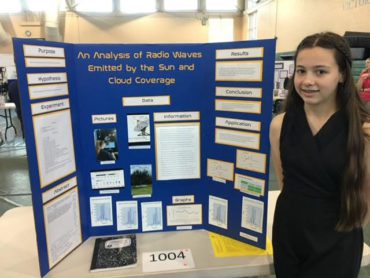
Project Title: “An Analysis of Radio Waves Emitted by the Sun and Cloud Coverage.”
